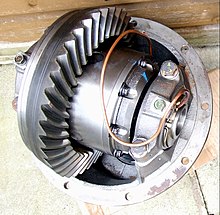This article needs additional citations for verification. (November 2018) |

A locking differential is a mechanical component, commonly used in vehicles, designed to overcome the chief limitation of a standard open differential by essentially "locking" both wheels on an axle together as if on a common shaft. This forces both wheels to turn in unison, regardless of the traction (or lack thereof) available to either wheel individually.
When the differential is unlocked (open differential), it allows each wheel to rotate at different speeds (such as when negotiating a turn), thus avoiding tire scuffing. An open (or unlocked) differential always provides the same torque (rotational force) to each of the two wheels on that axle. Therefore, although the wheels can rotate at different speeds, they apply the same rotational force, even if one is entirely stationary, and the other spinning (equal torque; unequal rotational speed).
By contrast, a locked differential forces both left and right wheels on the same axle to rotate at the same speed under nearly all circumstances, regardless of the tractional differences at either wheel. Therefore, each wheel can apply as much rotational force as the traction under it will allow, and the torques on each side-shaft will be unequal. (Unequal torque, equal rotational speeds). Exceptions apply to automatic lockers, discussed below.
A locked differential can provide a significant traction advantage over an open differential, but only when the traction under each wheel differs significantly.
All of the above applies to central differentials as well as to those in each axle: full-time four-wheel-drive vehicles have three differentials, one in each axle, and a central one (called a "transfer case") between the front and rear axles.